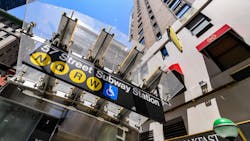New York City adopts zoning rules to advance transit accessibility
Elevate Transit: Zoning for Accessibility, a collaboration between the Metropolitan Transportation Authority(MTA), City Council, the Department of City Planning (DCP) and the Mayor’s Office for People with Disabilities (MOPD), was approved to boost New York City’s push to make its transit system fully accessible.
The initiative will allow the MTA to leverage planned private development to achieve a fully accessible transit system faster, while saving taxpayer dollars as the MTA faces financial challenges caused by the ongoing pandemic.
“Building a recovery for all of us means making public transportation accessible to everyone who rides it – especially seniors, young families and New Yorkers with mobility disabilities,” said Mayor Bill de Blasio. “I’m proud to work across government to drive greater investment in these accessibility improvements, and I look forward to collaborating on more creative ideas to make our city fairer and more equitable.”
Zoning for Accessibility incentivizes private developers to design their buildings to incorporate public station accessibility projects or build the improvements at nearby MTA stations. It creates a new set of tools – and strengthens existing ones – that build off the MTA’s commitment of more than $5 billion of funding for 77 accessible subway, Long Island Rail Road, Metro-North Railroad and Staten Island Railway station projects within New York City in the 2020-2024 MTA Capital Plan.
“Zoning for Accessibility builds on the MTA’s historic $5.2 billion investment in making our transit system more accessible, by using private development to accelerate ADA upgrades,” said MTA Acting Chair and CEO Janno Lieber. “This initiative reflects Governor Hochul and the MTA’s shared commitment to all New Yorkers — particularly riders with mobility disabilities, seniors and parents of young children — to modernize the entire transit system as quickly and efficiently as possible."
MTA Chief Accessibility Officer Quemuel Arroyo added, “The passage of Zoning for Accessibility is an exciting moment in the MTA’s efforts to expand accessibility to all New Yorkers across the entirety of our transit system. This legislation will harness the power of public-private partnerships to speed up accessibility enhancements and create a more equitable city for all New Yorkers and visitors alike.”
The proposal allows developers to help deliver transit station accessibility throughout the city in two ways: Easement certification and transit improvement bonus.
Easement Certification
This provision requires developers of most mid- or high-density sites adjacent to subway, Staten Island Railway, Long Island Rail Road and Metro-North Railroad stations within New York City to consult with the MTA first to determine whether the MTA needs an easement (permanent access to a small piece of property) for future accessibility projects at the adjacent station. Easements can play a critical role in helping to reduce expensive, time-consuming barriers to constructing elevators, such as underground utility relocations, and allow for station designs that better serve riders. If an easement is necessary, the developer would receive targeted zoning relief to offset the creation of an easement.
Transit Improvement Bonus
This provision expands the existing “transit improvement bonus” from central business districts to other high-density areas in the city. This program incentivizes private developers to directly fund and build new transit station access improvements, such as elevators or other circulation improvements at already accessible stations, in exchange for a floor area bonus of up to 20 percent. Accessibility improvements attained through the bonus mechanism are achieved at no cost to the MTA and will be in addition to projects funded through the MTA’s Capital Plan. Each bonus application will still require a public review and approval process.
These provisions will help free up funds for the MTA to make more stations accessible on a faster timeline and provide more accessible routes for its customers. Today, about 30 percent of the 493 subway and Staten Island Railway (SIR) stations in New York City are fully ADA-accessible.
